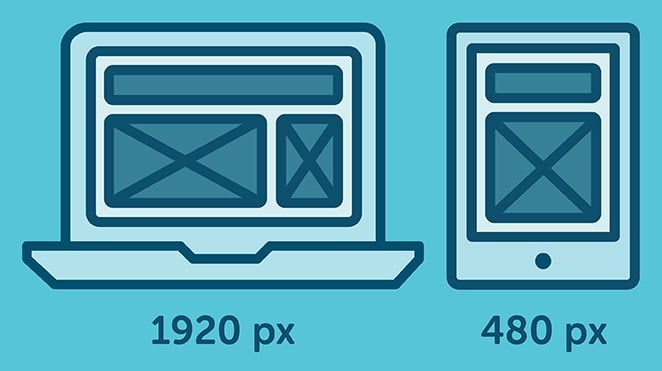5.9 KiB
| title |
|---|
| Breakpoints |
Overview
A CSS Breakpoint is a specific point in which a website's layout changes, based on a Media Query becoming active.
Generally, you specify a breakpoint when you want to re-adapt the website's layout to the browser viewport's size; mostly, to the viewport's width.
For example, if your website content looks great on a narrow viewport (like on a smart-phone browser), but it starts to look bad on bigger screens (e.g. maybe the fonts' sizes are too small and difficult to read), then you might want to introduce a new breakpoint for bigger screens that makes the fonts bigger:
CSS Breakpoints can be considered to be the heart of responsive webdesign because they define how the content behaves or is arranged at a different device width/scale allowing you to show the best possible layout to the user.
Setting Break Points
Breakpoints are broadly set on basis of either of the following.
- Breakpoints based on device width.
- Breakpoints based on content.
Breakpoints based on device width
It's quite apparent that all of our devices do not have the same screen widths/sizes. It is now a design decision to include a set of particular devices and code the css rules accordingly. We already have enough devices to worry about, and when a new one comes out with a different width, going back to your CSS and adding a new breakpoint all over again is time-consuming.
Here's an example
/* ----------- iPhone 6, 6S, 7 and 8 ----------- */
/* Portrait */
@media only screen
and (min-device-width: 375px)
and (max-device-width: 667px)
and (-webkit-min-device-pixel-ratio: 2)
and (orientation: portrait) {
}
/* Landscape */
@media only screen
and (min-device-width: 375px)
and (max-device-width: 667px)
and (-webkit-min-device-pixel-ratio: 2)
and (orientation: landscape) {
}
/* ----------- Google Pixel ----------- */
/* Portrait */
@media screen
and (device-width: 360px)
and (device-height: 640px)
and (-webkit-device-pixel-ratio: 3)
and (orientation: portrait) {
}
/* Landscape */
@media screen
and (device-width: 360px)
and (device-height: 640px)
and (-webkit-device-pixel-ratio: 3)
and (orientation: landscape) {
}
With this approach, you will end up having a huge list of media queries.
Breakpoints based on Content
This is the most preferred choice while making or writing the breakpoint rules. Because it is easier to adjust your content according a particular layout only when it requires a change.
@media only screen (min-width: 768px){
...
}
This breakpoint means the CSS will apply when the device width is 768px and above.
You can also set a range with breakpoints, so the CSS will only apply within those limits.
@media only screen and (min-width: 768px) and (max-width: 959px){
...
}
Note Always try to create breakpoints based on your own content, not devices. Break them to a logical width rather than a random width and keep them to a manageable number, so modifying remains simple and clear.
CSS breakpoints are useful when you want to update styles based on the screen size. For example, from a device measuring 1200px width and above, use the font-size: 20px;, or else use the font-size: 16px;.
What we have started with is from the greater than 1200px, a common laptop screen's width. You may also have noticed that we mentioned 'greater than', meaning that we are in a way using something like an 'if-then' statement.
Let's turn it into CSS code:
.text1 {
font-size: 16px;
}
@media (min-width: 1200px) {
.text1 {
font-size: 20px;
}
}
For our convenience, we write down the .text1 basic styling first... then afterwards we will specify the @media rules.
Tip: you may see on a common CSS Framework called 'Bootstrap', that they have adopted 'min-width' and up in their Bootstrap v4.0, as compared to their old Bootstrap v3.0 using 'max-width' and down. This is only a preference, and there is nothing wrong with saying 'this size and less than' versus 'this size and greater than'.
It is perfectly fine to use @media (max-width) {} . Here is an example:
.text1 {
font-size: 20px;
}
@media (max-width: 1199px) {
font-size: 16px;
}
// Normal, basic styles
// that look great on small screens
// but not on bigger screens
body {
font-size: 16px;
}
// Define a new breakpoint, with a media query.
// In this case, for when the viewport's width
// is at least 512px wide.
@media (min-width: 512px) {
body {
font-size: 20px;
}
}
Breakpoints that are based on content as opposed to device are less complicated. Here's a simple snippet that triggers when the device's width is upward of code 700px roughly smart-phone screen sized
@media only screen and (min-width: 700px) {
something {
something: something;
}
}
You can also set a minimum and maximum width, which lets you experiment with different ranges. This one triggers roughly between smart-phone and larger desktop and monitor sizes
@media only screen and (min-width: 700px) and (max-width: 1500px) {
something {
something: something;
}
}
